The Finding of Mr. X and the Gillingham Violet Chinchilla

(l-r) Mr. Douglas Frank Gillingham, Mr. Doug Milton, Rhodesian Prime Minister Ian Smith; (far right) a young Douglas Frank Gillingham in the British Royal Navy; Treasures of Rhodesia - Victoria Falls, the Sandawana Emerald, and the Violet Chinchilla
Part 2 of 3
Published Aug 9, 2025
The origin of the violet chinchilla, for 60 years, was one of the most closely guarded secrets in the chinchilla world. Join Chinchillas.com as we unravel the mystery...
The Finding of Mr. X
-Preface-
by Laurie (Soehn) Schmelzle
In 1993, I was a student at the University of California in Los Angeles, majoring in Biology and Philosophy, and an assistant researcher for Dr. John Heyning, Curator of Marine Mammals at the LA Museum of Natural History. Having grown up in Miami showing and training Arabian horses, I also had a lifelong interest in Egyptian Arabians, but it was very expensive to make mistakes when producing them. So I sought to further my understanding of Egyptian Arabian horse breeding by studying a domestic species that reproduced faster and less expensively than horses. The result of my search was a meeting with two of the world's most accomplished chinchilla breeders; Pete and Sue Kiseskey of PSK Chinchilla, located in Tehachapi, California. At the time, all the serious chinchilla breeders were pelters. Although Sue's goals regarding chinchillas were quite different from mine, we shared a common interest in genetics and in producing high quality animals. I spent several years as Sue's protege, grading chinchillas, and helping to select breeding and show chinchillas from PSK’s herd of 2,000-3,000 chinchillas. It was at PSK that I was introduced to the Sullivan Violet chinchilla, which the Kiseskeys had recently purchased from Loyd Sullivan along with the Sullivan Fur Dressing plant.
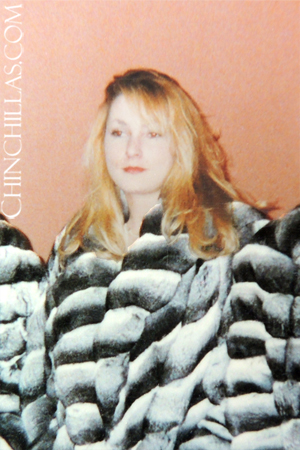
One of my first chinchillas was a juvenile TOV Violet male which PSK produced from the newly acquired Sullivan Violets. When I initially expressed interest in buying the young violet, there was no getting him away from Pete and Sue. Some months later, at a US National show in the mid 1990’s, many world class chinchilla breeders including Ralph Shoots and Vin Somavia donated one or two of their top animals (often attempting to outdo one another) to the popular fund-raising raffle. Ralph had two truly phenomenal Standard males in the raffle, and Sue wanted them. I bought a lot of tickets, and with luck won choices 1, 2, and 4. I finally had some bargaining leverage, and traded picks 1 and 2 to Sue for the TOV Violet. Happily (although Ralph was not happy), Sue went home with two of her competitor's top Standard males, and I finally acquired the TOV Violet I had wanted for so long.
(right) Laurie Soehn, US National Chinchilla Show, circa 1995
As the 1990's drew to a close, it was time for Sue & I to say goodbye. Pete and Sue were moving their operations to Parawan, Utah, and I left California with my husband Martin - an engineer at Hollywood Sound Recorders. Later, through an unanticipated chain of events, we founded Chinchillas.com and ran the business out of a backpack while traveling back and forth to California for Martin's work.
All this time, the history of the Violet chinchilla prior to their acquisition by Loyd Sullivan remained a mystery. Sue said that despite all the peer pressure Loyd endured, he kept the secret and took it to his grave.
Twenty five years later, in 2024, Sue unearthed a fragile hard copy account of 'Mr. X,' the unidentified & original breeder of the Violet chinchilla, among Loyd's business documents. After discussing it, we decided to publish the account, to share Loyd's story with the rest of the world.
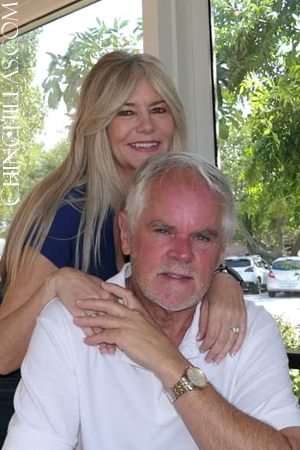 Meanwhile in Canada, a Rhodesian born man began thinking back to his childhood in Africa, wondering what ever happened to the special chinchillas his father had once owned and painstakingly cared for. While confined during the covid lockdowns, he initiated an internet search for more information. He began to uncover some information about Loyd Sullivan and started putting the pieces together. A couple years passed, and by chance he came upon the account of 'Mr. X and the Violet Chinchilla' on Chinchillas.com. Recognizing the striking similarity between the Mr. X article and his own recollections, he decided to reach out.
Meanwhile in Canada, a Rhodesian born man began thinking back to his childhood in Africa, wondering what ever happened to the special chinchillas his father had once owned and painstakingly cared for. While confined during the covid lockdowns, he initiated an internet search for more information. He began to uncover some information about Loyd Sullivan and started putting the pieces together. A couple years passed, and by chance he came upon the account of 'Mr. X and the Violet Chinchilla' on Chinchillas.com. Recognizing the striking similarity between the Mr. X article and his own recollections, he decided to reach out.
In the spring of 2025 while on a business trip in California, I got a call from Sue who said "you’ll never guess who I just head from? Mr. X’s son!... and we had a very nice conversation." Somewhat shocked and more than a little skeptical, I replied “Well, who is he… what’s his name?” To which Sue replied, “I don’t remember, but he’s going to contact you.” Unconvinced, I laughed at the irony of potentially finding Mr. X (or his son) and immediately losing him again, but Sue was confident. Several weeks later, I did indeed hear from a well spoken man with an English accent. His name was Mark Gillingham, son of the infamous Mr. X! It was one of those unforseen life moments that seems somewhat surreal. Connecting the two long lost halves of the story was an unexpected surprise for all of us.
(left)
Mark Gillingham and his wife Caroline, 2021
The Infamous Mr. X and the Gillingham Violet
As Mark Gillingham described (quoted in italics henceforth), "It's amazing that after nearly 60 years the mystery of the origin of the Violets is disclosed. I'm so glad that, while bored during COVID and thinking of the past, I became curious of what happened to those mutation Chinchillas my dad was so proud of back in the 60s and 70s."
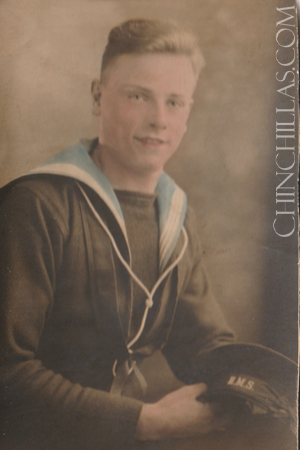 Mark Gillingham’s parents were from England. His father, Douglas Frank Gillingham, or 'Frank,' as he's called at home, served on a British warship in WWII at the young age of 16 (pictured, right). After surviving the war, he moved to Rhodesia in May of 1948 to grow tobacco.
Mark Gillingham’s parents were from England. His father, Douglas Frank Gillingham, or 'Frank,' as he's called at home, served on a British warship in WWII at the young age of 16 (pictured, right). After surviving the war, he moved to Rhodesia in May of 1948 to grow tobacco.
Between 1953 and 1955, Frank became involved with chinchillas. Mark describes his father as "very professor-like, very inventive. My father kept the chinchillas in proper brick air conditioned buildings – two of them. One had a small hospital and a quarantine for housing chinchillas separately from the rest of the herd. He made his own automatic waterers, and kept heaters by the cages/dust boxes for new litters."
Mark recalls, "My father, Douglas Frank Gillingham, back in about 1966 -1967 was very excited about a mutation family of Chinchillas that he had bred on our farm about 15 kilometers outside Salisbury, Rhodesia as it was called at the time."
"There is a possibility that maybe in 1963 there was a hint of a Violet mutation in a litter and my dad then tried to improve the quality, but I definitely remember great excitement about the mutation in around 1966. So the possibility is that he managed to in 1966 have a litter that was in his opinion of excellent quality after 3 years of effort.
Mark remembers one particular night, perhaps during the summer or a holiday while he was home from boarding school, his father woke him and his mother up, being extraordinarily excited about a new litter of chinchillas that had just been born. They all went down to the barn to see the new ‘special kits.' The next morning, Mark’s father was visibly worried. Frank tried to stress to Mark the importance of keeping the Violets a secret, whether due to concerns about disease, or as Mark suggests "In 1965 / 66 as I would have only been 6 or 7 years old, all I remember is him asking me not to mention the mutations to Jaqueline who was Ian Tippets Aylmers' daughter and Mike who was Doug Milton's son. I was childhood friends with these two Chinchilla breeders' children. The only reasons I can think of is that this may have been the first successful litter with the definite Violet colouring after years of experimenting and considering the close association the Chinchilla Breeders had with my dad, he may have not wanted the constant curiosity of visiting breeders wanting to view the litter. But my gut feeling is that with war looming in the near future and sanctions firmly in place against Rhodesia in 1966, it would have been common sense to keep quiet about the mutations due to their value and somehow get them to South Africa." Fortunately, even being so young, Mark took his father's request seriously and told no one.
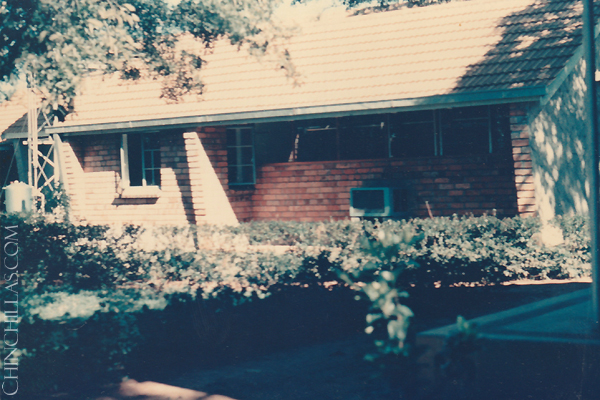 The birth of the special kits as described by Mark was likely the evidence Frank had been waiting for; proving that he had a reproducible true-recessive on his hands. When the presumed first generation was born from the original mutant, assuming all were Standard, Frank would have known he either had a recessive, or nothing (meaning something that could not be reproduced). It would have taken a few years for a breeder to reproduce a recessive mutation, first having to produce carriers. Not being a chinchilla breeder, Mark perhaps thought that all the excitement was from an improvement in quality, rather than the first appearance of the phenotype following mutagenesis. Frank, however, would have known what he had; being a viable, reproducible true recessive, and hence be excited enough to wake the whole household in the middle of the night!
The birth of the special kits as described by Mark was likely the evidence Frank had been waiting for; proving that he had a reproducible true-recessive on his hands. When the presumed first generation was born from the original mutant, assuming all were Standard, Frank would have known he either had a recessive, or nothing (meaning something that could not be reproduced). It would have taken a few years for a breeder to reproduce a recessive mutation, first having to produce carriers. Not being a chinchilla breeder, Mark perhaps thought that all the excitement was from an improvement in quality, rather than the first appearance of the phenotype following mutagenesis. Frank, however, would have known what he had; being a viable, reproducible true recessive, and hence be excited enough to wake the whole household in the middle of the night!
(left) One of the chinchilla buildings at Frank Gillingham's farm in Salisbury, birthplace of the Violet chinchilla
…I clearly remember him taking excessive care by separating these chinchillas from the rest of the herd in a very clean air conditioned building. Over the next few years my dad bred them to an approximately 30 in quantity.
My dad for some reason kept the mutations completely separate in a much more temperature controlled environment. I think at first the fatality rate was fairly high. I clearly remember him always washing his hands and wearing a white coat when handling the infant mutation chinchillas. We had a lot of visitors and other Chinchilla Ranchers at the ranch and possibly didn't want too much publicity and people wanting to look at them and possibly infecting them... who knows? I always remember him being paranoid about temperature in the buildings and diseases. At one time I had about 5 rabbits , and one became very ill and died and due to my dad not knowing what the rabbit died of, he ended up removing the rabbits from the farm to my Grandpas home until he was 100% convinced the rabbits were in good health."
Mark is fairly certain that his father’s original Violet mutated out of Standards, owing to the fact that Frank had very few mutations in his herd.
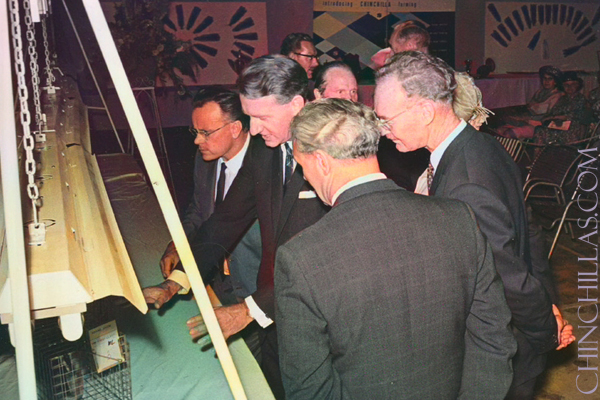 Frank worked hard and enjoyed putting on posh events, even appearing alongside Rhodesian Prime Minister Ian Smith. Frank had become somewhat of a public figure in Rhodesia, being appointed Chinchilla Specialist of the Rhodesian government, as the government felt that the export of pelts would bring in a lot of revenue.
Frank worked hard and enjoyed putting on posh events, even appearing alongside Rhodesian Prime Minister Ian Smith. Frank had become somewhat of a public figure in Rhodesia, being appointed Chinchilla Specialist of the Rhodesian government, as the government felt that the export of pelts would bring in a lot of revenue.
(pictured, clockwise from left) Douglas Frank Gillingham, Prime Minister Ian Smith, Ian Tippetts-Aylmer, Doug Milton, circa 1965
During the 1960’s, Mark remembers a frequent American visitor, although he didn't know the name at the time. It was Loyd Sullivan. His father Frank had made a trip to the US to visit Loyd’s farm in Oakhurst, and at least one trip that coincided with the first NASA mission to the moon in July of 1969, from which he brought mementos to his family. It was a great time with the advent of the Violets. But, all good things must come to an end, and perhaps this time it came too soon. War was brewing in Rhodesia, and Frank needed to get his family out. The Violets would be the key.
"Unfortunately sanctions were internationally imposed on Rhodesia in late 1960s immediately stopping any outflow of pelts or Chinchillas beyond Rhodesia’s borders.
During that period my father had met Loyd Sullivan and even taken a trip to the USA as a guest on his Chinchilla Farm. With war now approaching Rhodesia my dad decided to immigrate to South Africa and that is when the deal/arrangement was made that the mutations would be sold and funds deposited in a South African bank for my father. Times were very difficult at the time and the Rhodesian Government had extremely strict foreign exchange control. Families were restricted at how much money they were allowed to take with them when emigrating and believe me it was very little. I was very young at the time, possibly 10 years old but clearly remember my dad covering a mid size brown trailer, maybe 9 feet long and 8 feet wide, which had about 3 layers of chinchilla cages with about 10 cages per layer. My dad left and returned about a week later with the trailer that was empty. Few months later we immigrated to South Africa and I never saw or spoke about those special chinchillas again."
Mark watched his father leave their driveway, having said nothing about where he was going or when he would return. Mark never saw the Violets again, and his father never again spoke of them, even into old age. In 1971/1972, Frank’s family emigrated to Port Elizabeth, South Africa. When they arrived, Frank had just enough money to buy a farm, where he started a dressing plant and a lion park.
"It was only in about 2020 during covid that I began to think back to those days and searched on Google about any mutations during the late 60s and came across the story of Loyd Sullivan and the name rang a bell. With a bit of research I was able to link my dad with Loyd through newspaper articles plus with his description of my dad in his articles. My dad had a very English accent, lived just outside Salisbury, had mutations at the time, grew tobacco, immigrated to South Africa plus had a close association with Loyd Sullivan. In Loyd Sullivan’s article he describes my dad and his situation accurately.
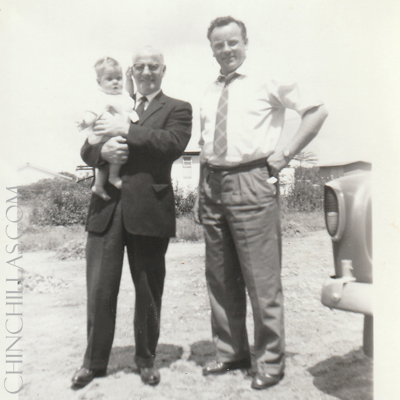 (left) Douglas Frank Gillingham with his father and his 7 month old son Mark on Christening Day, circa December 1959
(left) Douglas Frank Gillingham with his father and his 7 month old son Mark on Christening Day, circa December 1959
The newspaper articles articulate his position in the Chinchilla industry in Rhodesia plus his close association with Loyd Sullivan of Oakland.
"I was only about 10 at the time and never thought to question what had happened to these very special Chinchillas that had brought so much excitement to my dad... My dad passed away back in 1999 so I couldn't ask him, and as I knew that these Mutation Chinchillas were so very important to him back in late 60s and early 70s that I decided to Google Mutation Chinchillas of that late 60s era and so here we are after my enquiries that led me to the Violet Chinchilla and its history which matches 100% to my recollections.
With regards the article of “Elusive Mr X" by Loyd Sullivan, all align as my dad was the only British Chinchilla Rancher on the outskirts of Salisbury, having immigrated to Rhodesia from Britain in 1948 plus as per the USA Newspaper article he had a close association with Loyd Sullivan.
During that period in Rhodesian's history, families were very limited in the amount of funds you could take when emigrating. You were only allowed a certain amount per adult and child. The rest of your equity had to be left behind in your name in Government bonds etc, so it would have been wonderful and convenient to have had funds for the Mutations deposited in a South African bank account. At the time it was illegal due to sanctions imposed by the US on Rhodesia for my dad to have sold the Mutations out of Rhodesia, thus the cloak and dagger arrangement that was done."
Like Bilbo and the Ring in J.R.R. Tolkien’s (incidentally born in South Africa) The Fellowship of the Ring, occasionally one comes upon an unexpected treasure and then finds himself in the arduous position of having to relinquish it. Such was the case with Mr. X. People who have devoted their lives to producing and improving many generations of special animals find it quite hard to part with them. The animals take sacrifice, and over time that person’s choices, selections, and their own attributes becomes integrated into the herd itself. This situation was amplified for Frank Gillingham because of the fated emergence of the Violet chinchillas. Parting with them must have been something deeply personal for Frank, compounded by the difficulty of keeping it all a secret. But in the end the story of Mr. X was ultimately a story of a man protecting his family, being his greater treasure.
And thus Mr. X, whose identity was thought to be lost forever, is finally made known. Salute! Douglas Frank - & thank you for giving the world this unique and special mutation.
-the end-
Part 3 of 3
Published September 30, 2025
- Appendices -
As a child, Mark Gillingham collected photographs & articles about his father Frank Douglas Gillingham (aka Mr. X). Fortunately, Mark kept these documents safe all these years. Explore this historic archive within the timeline below.
Timeline of the Violet Chinchilla
click on the underlined links
circa 1917
Loyd G. Sullivan is born
April 17, 1923
Douglas Frank Gillingham is born
1939
Britain declares war with Germany. Douglas Frank Gillingham, known as 'Frank,' joins the military at the age of 16 and serves for 5 years (1940-1945) on a British warship
May 20, 1948
Frank Gillingham immigrates to Rhodesia from England to grow tobacco
1951
Letters of Recommendation
from Frank Gillingham's employers in the tobacco industry
circa 1953-1955
Frank Gillingham first becomes involved with chinchillas
1959
Frank's son Mark was born on May 19th
Photographs of Frank Gillingham with his father and his infant son
circa 1955-early 1960's
June Gillingham - Chinchilla farming in Salisbury newspaper article
circa 1955-1963
Gillingham to head giant chinchilla ranching complex newspaper article
1963
The most likely date of birth of the first Violet mutation born on Frank Gillingham’s farm
circa 1965
the Gillingham Chinchilla Ranch in Salisbury (now Zimbabwe), Africa
Birthplace of the Violet Chinchilla
1966
The most likely date that the F1 generation of Violets was born on Frank Gillingham’s farm
May 20th, 1966
chinchillas… or the art of ranching in your garden
published by Rhodesian Farmer
June 10th, 1966
The Ultimate of Furs - Q&A Interview with Frank Gillingham
Published by Rhodesian Farmer
1966
Frank Gillingham is appointed as the Rhodesian Government's official Chinchilla Specialist
July 11th, 1966
Chinchilla Expert Appointed
published by Rhodesian Commentary
1960's
Photographs of Frank Gillingham at a Chinchilla Breeder's Association Event with key figures in the industry
May 23, 1968
Frank Gillingham visits Loyd Sullivan's ranch in California
Southern Rhodesian Visits Fur Plant newspaper article
Published by Madera Daily Tribune
June 30, 1969
The Republic of South Africa issues Immigration Permit
to Frank Gillingham and his family. The family does not actually make the move for another two years
July 1969
Frank Gillingham visits the USA, being in the country when NASA sent Armstrong to the moon. He returned to Rhodesia with postcards and memorabilia of the famous event
circa 1971-1972
Mark Gillingham watches his father's truck, loaded with three stacks of chinchilla cages, depart from their driveway in Salisbury. Mark Gillingham, aged 10, never sees his father's special Violet mutations again
circa 1971-1972
The Gillingham family emigrates from Rhodesia to Port Elizabeth, South Africa
1973
Mark Gillingham attends boarding school in South Africa
1975
The Violet chinchillas left South Africa, bound for the United States. Loyd Sullivan anxiously passes the time with good friends Pete and Sue Kiseskey (see '1975' date discrepancy below)
1975
The date Loyd Sullivan states that the Violet chinchillas left Rhodesia. In 2025, the date of the Rhodesia-South Africa leg of the journey is contested by Mark Gillingham who recalls the correct date being closer to 1971-1972. Speculatively, Frank and Loyd may have skewed the dates on purpose. It is most likely that the Violets were moved from Rhodesia to South Africa in 1971-1972, and then from South Africa to the USA in 1975. The rest of Loyd Sullivan's account is deemed correct by Mark Gillingham.
circa 1985
Loyd and Patricia Sullivan are photographed at the Grand Hotel in Orange City, California
1984 – 1988
Loyd Sullivan begins selling the Violet chinchillas to prominent breeders in the USA and exporting to multiple countries
1989
Loyd Sullivan trademarks 'Celestial Chinchilla' as the name of the Violet chinchilla pelts. The trademark is later transferred to PSK Chinchilla
1990's
Pictures of Frank Gillingham and his family
circa 1990-1992
Pete E. and Susan M. Kiseskey / PSK Chinchilla, good friends of Loyd Sullivan, purchase the Sullivan Violet herd and the Sullivan Dressing Plant
January 14, 1999
Douglas Frank Gillingham passes away at the age of 75
Articles and images in the Appendices are property of their respective owners. They are watermarked Chinchillas.com to counter AI infringement. Documents from and images of the Gillingham family courtesy of the Mark Gillingham family archives. Special thanks to Mark Gillingham and Sue Kiseskey for helping to make this article, and this discovery possible.
Associated articles:
The History of the Violet Chinchilla (Part 1 of 3)
Mr. X and the Violet Chinchilla, by Loyd Sullivan
